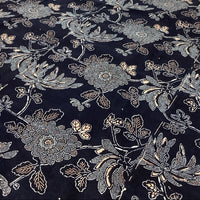
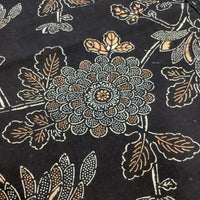
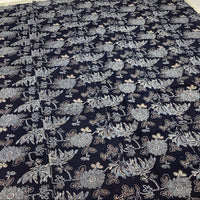

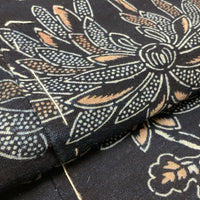
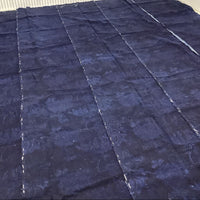
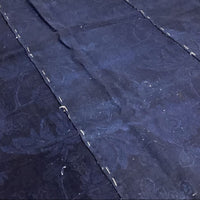

Antique Indigo & Bengala Futon-ji – Floral Katazome, 5 Panels Wide
A richly patterned example of antique Japanese futon-ji, this cloth once served as the outer covering for a hand-stuffed futon mattress. The surface is alive with floral katazome work—crisp outlines, scrolling stems, and warm undertones created by a second layer of dyeing. Even at first glance, the depth of color and patterning speaks to the skill and care that went into making textiles for the home before industrial printing was widely adopted.
This futon-ji was formed by stitching together several narrow handwoven panels. In rural households, cotton was woven on small-width looms—typically 13.5–14" wide—and then joined edge-to-edge to create a large cloth. The seams you see today still tell the story of that slow, domestic labor. The patterning itself was created with katazome, a traditional Japanese resist-dye method where artisans brushed rice-flour paste through hand-cut mulberry stencils. After dyeing the cloth deeply in natural indigo, makers sometimes added additional warm tones with bengala (iron-oxide pigment). The soft rose-brown hues in this textile indicate that historic technique.
Because futon-ji were lived with daily, they often show generations of mending and use. However, this piece was likely stored for a long time because it has very few of the signs of wear typical of its age. It still remains structurally sound and visually striking. Whether displayed as a whole cloth, studied for its dye technique, or used in contemporary making, it retains its quiet dignity and long, handmade history.
Age & Attribution
This cloth qualifies as antique, likely dating from the late Meiji (1868–1912), Taishō (1912–1926), or early Shōwa (1926–1989) periods. Several characteristics support this dating:
-
the narrow panel widths produced by pre-industrial cottage looms,
-
the complexity of the katazome stencil work,
-
the deep, layered indigo tone with warm over-dyeing, and
-
the hand-sewn seams typical of household futon covers.
While its exact provenance cannot be confirmed, its materials, pattern style, and construction strongly suggest early 20th-century origin. We share this reasoning so you can understand the visual and structural clues used in Japanese textile dating.
Dimensions:
63" × 77" (160 × 195 cm)
5 panels wide, based on the standard traditional loom width of approximately 13.5–14" per panel before seam allowances. This is considered a larger-than average futon-ji.
Made in Japan








